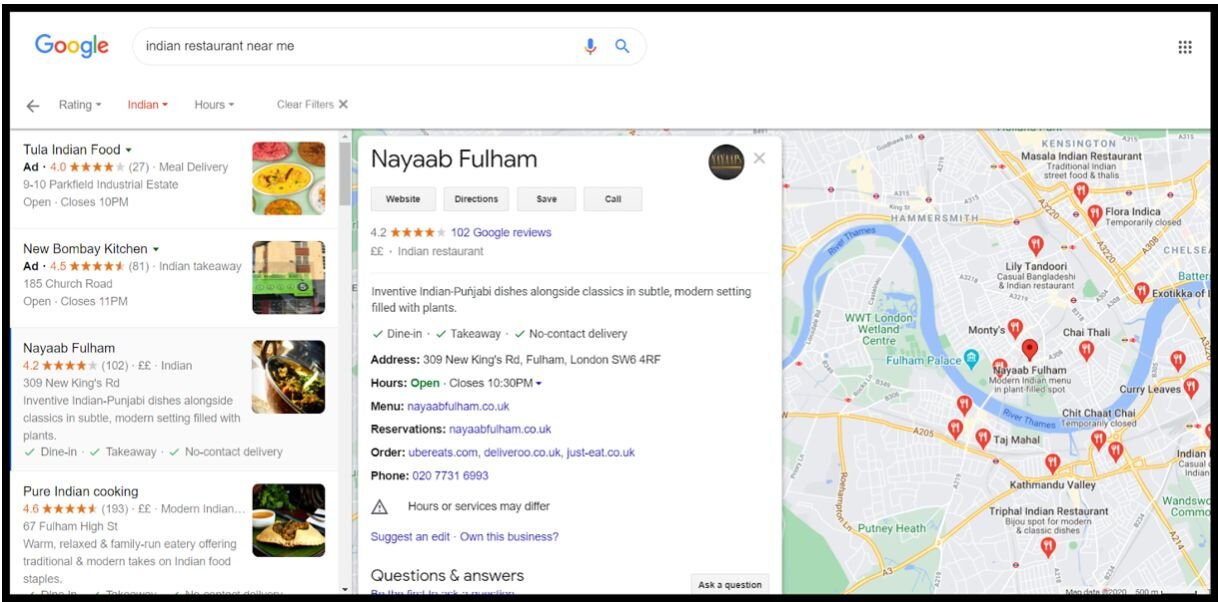How to Optimize Your Restaurant’s Ranking in Google Maps

Mikayla Walzog
5 min read
Nov 13, 2020


Mikayla Walzog
5 min read
Nov 13, 2020

One of the most common ways that customers find nearby restaurants is by running the following search: “X restaurant near me”, where X stands for a type of cuisine. Search volume numbers back this up. Here are the following average monthly volumes in the United States of “near me” searches for some of the most popular types of cuisine: “Mexican restaurant near me” – 114,000 monthly searches “Chinese restaurant near me” – 85,000 monthly searches “Italian restaurant near me” – 60,000 monthly searches “Indian restaurant near me” – 58,000 monthly searches While a searcher’s location and proximity to certain restaurants partially determines what restaurants come up for a “near me” search, there are other determining factors that a restaurant owner can control. Here is a rundown of what you can do to rank your restaurant well for “near me” searches.
Before we go into how to rank well for “near me”, we must first look at what the search engine displays when someone makes this type of search. Here is what is shown when someone searches: “Indian restaurant near me” (in this instance the searcher is in London).
Search results for an ‘Indian restaurant near me’ in London What’s important to note here is that it’s not the traditional “organic” results that get displayed at the top of Google. Rather a user is presented with an interactive Google Map of their area, studded with clickable pointers marking relevant restaurants. Three restaurants will also appear below this, with their opening times, average rating, location and photos displayed. This interactive map gets the lion’s share of the clicks for “near me” type searches. This is particularly true when a user is searching on a mobile device, which has been the norm since 2019. You should therefore shift your aim from trying to rank in the traditional organic positions, to trying to rank in the Google map – essentially the shift from SEO to local SEO. Below are the most important factors to ranking well in the Google Map.
When Google displays its map in response to a search, the embedded features that it displays are the Google My Business profiles of relevant businesses. This means that if your restaurant does not have a Google My Business profile, then you have zero chance of appearing on the map. Claiming your Google My Business listing is a necessity to have any presence in a “near me” search. Here is how you do it:
Given that Google wants to provide the most informative results to its users, Google My Business profiles that are completely filled out will be displayed more prominently than those that are not. You should therefore try to complete every field in your listing. These fields can include:
Try to complete every field possible to improve your ranking.
To further confirm that your restaurant is at the location stated on your Google My Business profile, Google’s algorithm looks for other instances on the internet of its name, address and phone number (NAP). You should therefore try to create citations of your NAP where possible. The best places to create these citations are on directory sites, like Yelp, Foursquare, and Zomato. When creating these, you must ensure that the instances of your NAP are consistent across the various platforms. Google will treat “Albert Street” and “Albert St” as different locations, creating confusion as to where your restaurant is located, and making it less prominent on the map. Older citations should be reviewed for inconsistencies. This is as important as creating new ones. Some directories require a small annual payment in order to be listed. It’s generally well worth paying for these to get an additional NAP citation, particularly if there are lots of other restaurants in your local area competing for online visibility.
Click-through rate refers to how often your restaurant’s profile is compared to the other profiles in the map listing. You should look to maximize your click-through rate for two reasons.
There are two key ways that you can maximize the click-through rates of your listing. These are:

If you are a chain in multiple locations, then it’s possible to set up a Google My Business profile for each location, and therefore compete for map space in each area. However, there are a few important practices to follow when you are optimizing your online profile for multiple locations. Firstly, each profile listing needs to be given a different name. The easiest way to do this is by adding your location to the end of your restaurant’s name on your listing. For example, if Tom has two Chinese restaurants, one in Brooklyn and one in Queens, their names on their Google My Business listings would be “Tom’s Chinese Restaurant Brooklyn” and “Tom’s Chinese Restaurant Queens”. A second rule to follow is that you should not add the same webpage to multiple Google My Business listings. To circumvent this, you need to create multiple location pages for each location, complete with unique web copy relevant to that location. This page should act as a landing page that encourages users to make a booking, so include your restaurant’s location, opening hours, and links to any reservation platforms on that page. Other than that, the process of setting up and optimizing Google My Business accounts for multiple location restaurants is the same as single location ones.